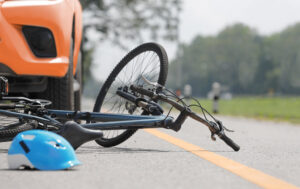According to many statistics, more and more people are turning to bicycles for commuting or daily exercise. It provides people with a way to reconnect with nature as they’re cycling on Colorado’s scenic hiking trails, and they can be much faster than cars when riding to work in a congested downtown area like downtown Denver.
However, there will always be dangers on the road, and irresponsible drivers cause many traffic crashes involving bicyclists every year. If you or a loved one suffered an injury in a bicycle crash, you should speak to a bicycle accident attorney as soon as possible.
What Are Some Types of Bicycle Accidents?
Many different types of bicycle accidents can occur due to motorist negligence. Left and right cross collisions are hazardous for bicyclists and are very likely to occur if a motorist is not paying attention.
These accidents happen when a car pulls out, and the driver doesn’t see the bicyclist about to pass. The result is the bicyclist getting struck directly or crashing into something because they do not have enough time to brake or swerve. Whether a driver is making a left or right turn, these accidents are preventable yet are one of the most common types of accidents involving bicyclists.
Rear-end collisions are another common type of bicycle-car accident and can cause severe injuries and even death. They often occur when a driver is riding too close behind a cyclist out of aggression or because they are simply not paying attention. These accidents can also occur when a bicyclist swerves to avoid a road hazard and end up directly in a car’s path. Drivers must always be attentive and respect the space between them and bicyclists in case an emergency happens, and they have to brake.
Another common bicycle accident is known as a dooring accident. These accidents tend to happen in more heavily populated cities with a lot of parallel street parking. As a bicyclist is going by in their respective lane, a parked motorist swings the door wide open without checking first to see if a bicyclist is about to pass. The bicyclist then either crashes into the car door or swerves right into traffic to avoid it, which can cause a severe accident. These accidents tend to happen in more heavily populated cities with a lot of parallel street parking.
Does Speed Play a Part in Bicycle Accidents?
Speed kills. It’s a common slogan in public safety campaigns around the country, and it’s particularly true when it comes to bicycle accidents. Nevertheless, even bicycle accidents that occur at low speeds can be serious and they can even be fatal. Out of the 13,704 crashes involving bicyclists that took place in the last decade in Colorado, the majority of them involved vehicle speeds of 15 miles per hour or less.
What Is the Most Common Way a Bicycle Accident Happens?
In Colorado, according to the Department of Transportation, 13,704 crashes involved bicyclists over the last decade.
Distracted driving causes many of those bicycle-car accidents.
- Manual distractions entail being distracted with the hands, most observed with drivers who eat and drink or text while driving.
- Visual distractions involve being distracted by your surroundings, such as watching pedestrians pass or looking above at billboards – basically seeing anything that takes the eyes away from the road in front. At 55 miles per hour, taking the eyes off the road and sending or reading a text for five seconds equals driving the entire length of a football field with the eyes closed.
- Cognitive distractions involve something that is very easy for drivers to do without even knowing they are doing it: daydreaming. Getting lost in thought is extremely dangerous because although the eyes may be looking at the road, the mind is not.
Some specific activities that are common driver distractions include:
- Texting
- Reading email or browsing the internet
- Grooming
- Applying makeup
- Changing the radio station
- Looking for items in the vehicle
- Talking to passengers
- Looking at scenery
- Attending to children
What Types of Injuries Can a Bicyclist Get?
Bicyclists are extremely vulnerable to suffering serious injuries in accidents, even when they are wearing helmets and other protective gear. If the bicyclist becomes trapped under the car, which is not rare, they can suffer bone fractures, internal bleeding, and punctured lungs.
If not treated right away, these can lead to death. Paralysis can result if there is severe damage to the spinal cord. It might be paralysis of just one or two limbs, but it can often lead to complete paralysis below the site of the injury.
Some of the most severe injuries involve hard blows to the head. Some of the most severe injuries involve hard blows to the head. Even with a helmet, head trauma can result in concussions or other types of traumatic brain injury (TBI). These injuries require urgent medical treatment and will most likely be fatal if not attended to immediately. The effects of a TBI can last for months or even be with the individual for life.
Every day, about 176 Americans die from TBIs. One wrong move from a driver can lead to a bicyclist suffering from a TBI, potentially ruining their lives forever or killing them on the spot.
Motorists Often Cause Bicycle Accidents
About 60 percent of the time, drivers were at fault for bicycle-vehicle accidents. Many drivers are aggressive towards bicyclists because they do not see them as vehicles. It is also easier to be distracted by the phone in a car than on a bicycle since, for most people, a bicycle usually requires both hands on the handlebars. Many motorists also may need to learn that bicyclists have the same rights as other vehicles on the roads.
In some situations, drivers may try to argue that it was the bicyclist’s fault because they may have suddenly dashed out in front of them. However, because of other drivers, at times, bicyclists are forced to swerve in traffic.
For example, assume a bicyclist is riding down their lane, and a parallel parked car opens their door without looking first. The bicyclist has no option but to swerve in front of oncoming traffic because otherwise, they will crash straight into the door. In this case, although the bicyclist rode in front of an oncoming car, their action resulted from another driver’s irresponsibility in being vigilant enough to watch out for passing bicyclists.
What Do Colorado’s Winters Have to Do With it?
 Colorado is known for having rather beautiful, scenic, and heavy snowfalls. One might wonder if all that snow affects the rate of bicycle accidents. Not surprisingly, the winter months have the least amount of bicycle accidents. Colorado’s winters help to reduce the number of bicycle accidents because many cyclists choose to engage in activities that are more appropriate for the conditions, such as skiing or snowboarding.
Colorado is known for having rather beautiful, scenic, and heavy snowfalls. One might wonder if all that snow affects the rate of bicycle accidents. Not surprisingly, the winter months have the least amount of bicycle accidents. Colorado’s winters help to reduce the number of bicycle accidents because many cyclists choose to engage in activities that are more appropriate for the conditions, such as skiing or snowboarding.
Nevertheless, the roads during winter are dangerous, and drivers are often getting into accidents due to black ice and other hazardous conditions. If a bicyclist decides to cycle during snowy weather, the chances of accidents are higher because it becomes harder for cars to stop and turn on the icy roads. In these conditions, drivers must be wary of not getting too close to vehicles in front of them or pedestrians or bicyclists. Any wrong move can send them uncontrollably sliding down the road, potentially leading them to hit unsuspecting bicyclists.
What Are Some Colorado Bicycle Laws in Place?
While Colorado does not have helmet safety laws, they have other measures in place intended to make the roads safer for all bicyclists. The Department of Transportation has many different resources and events dedicated towards their safety, like Colorado Bike Month, Bike to Work Day, and many other resources like signs that businesses and parks can put up.
There are many bicycle laws for drivers in Colorado to promote more road safety. For instance, vehicles must stay at least three feet from the cyclist. Additionally, it is a criminal offense to make any threats against a bicyclist, which is vital as bicyclists already have to deal with harassment from drivers while on the road.
A driver can face many penalties if they cause severe bodily harm to a bicyclist out of malice, such as receiving a class 1 misdemeanor and a license suspension. Drivers may only pass a bicyclist on their side if the path in front is entirely free of oncoming traffic. They must provide the bicyclist with plenty of space so that they can do this safely.
What Determines Right-of-Way?
Since bicycles are considered vehicles in Colorado and are subject to the same rules of the road, it leaves us with the question of who has the right-of-way in different traffic situations. Intersections are the most dangerous and familiar location for bicycle accidents. Bicyclists and vehicles need to know who has the right of way. If the intersection has traffic signals, the vehicle (car or bicyclist) with the green is the one with the right-of-way.
When at intersections without signals, the rules get slightly trickier. First, whichever party has no stop sign has the right to continue, whether a bicycle or car. If the bicycle and the car stop simultaneously at the same stop sign, whichever vehicle is on the right can go first. This right means that if a bicyclist is to the car’s right, the car must yield the right-of-way to them. If the car and bicyclist approach different stop signs simultaneously, whichever vehicle was the first to stop is the one that goes.
What Else Colorado Does Do to Prevent Bicycle Accidents?
Drive Smart Colorado is a state program dedicated to providing essential resources to all types of drivers, such as older drivers, motorcycles, school buses, and bicyclists. They focus on maintaining bicyclists’ safety in different types of weather conditions and across different terrains and on how to prevent accidents. There is also a program called Bicycle Colorado that helps teach adults about the safety of navigating with bicycles among motor vehicles.
What Should I Do After a Bicycle Accident?
A bicycle accident can leave an individual scared, confused, and in pain. They might need to figure out what to do next once the scene gets cleaned up. Here are some of the steps you should take to protect your rights after a bicycle accident:
See a Doctor and Follow Your Treatment Plan
You should see a physician after any bicycle accident, even if you think your injuries are relatively mild and will heal by themselves. When you see your doctor, it will result in the creation of a medical record that you can use as evidence of your injuries if and when you make a claim.
You should also be sure to follow your treatment plan in the letter. Doing so means attending any follow-up appointments your doctor recommends, filling and taking your prescriptions, and attending any physical therapy that is prescribed. If you do not, the other side may argue that you did not take adequate steps to mitigate your damages, which can hurt your claim.
Do Not Accept a Settlement Offer
You may be approached with a settlement offer in the immediate days or weeks after your accident, either by the at-fault party or their insurance company. Quick settlement offers are almost always an attempt to limit liability by getting victims to sign away their rights before they know how much their cases are worth. As a result, you should always speak to a lawyer before you sign a settlement agreement.
Contact a Bicycle Accident Attorney Today
When you suffer an injury in a bicycle crash caused by someone else, you deserve compensation for medical bills, lost wages, and other damages. Talk to a bicycle accident attorney today about your case.




















